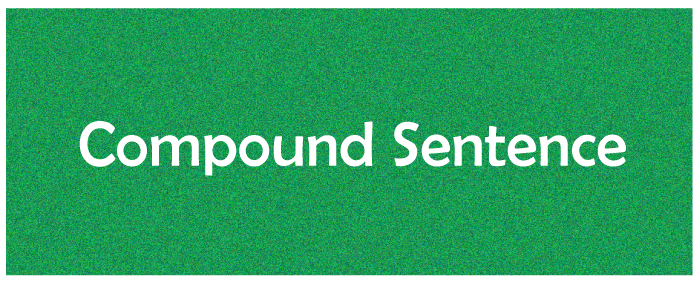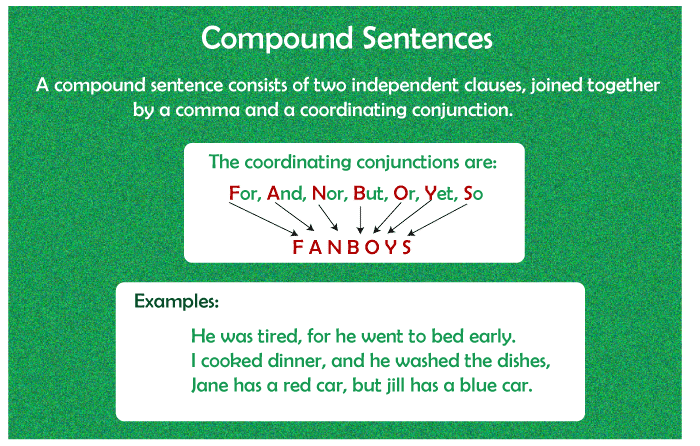Compound SentenceCompound sentences are the ones which link two independent clauses along the coordinating conjunctions, like and or but. Moreover, these perform finest when they are integrated with two or more self-contained and linked sentences, Thus forming a single, complete sentence. 
Compound sentences speed up your writing and connect related concepts, but they have a few additional constraints than regular sentences. In this quick guide, we'll show you how to use them correctly to give your writing a competitive edge. What Exactly Is a Compound Sentence?Compound sentences, as discussed in this article on how to build better sentences, merge two or more independent clauses. Independent clauses, or clauses that can exist independently as individual sentences, are essential here. Moreover, a compound sentence, in particular, merges various related statements into one. Also, these sentences are simple to understand since they typically contain a coordinating conjunctions that you may recall as FANBOYS: For, And, Nor, But, Or, Yet, and So. Compound sentences, on the other hand, can utilize a semicolon to join two clauses, in which case no conjunction is required. 
Let's examine a few examples of compound sentences to see how they behave. Examples Of Compound SentencesHere are two short sentences. Since they each possess their own subjects and verbs, these are both independent sentences. I have a beagle puppy; his name is Silky. To make a compound sentence out of them, one needs to easily place a comma followed by the coordinating conjunction i.e. 'and'. I have a beagle puppy, and his name is Silky. Alternatively, we can build a compound sentence with only a semicolon, and it will still be correct. I have a beagle puppy; his name is Silky. Despite the fact that they are discussing the same subject, the subjects of each statement are distinct: the first statement's subject is I, whereas the subject of the second statement is the name. That is one of the reasons they are independent because compound sentences can only be used with independent clauses. The statement below, for instance, is not a compound statement. I have a beagle puppy whose name is Silky. A compound sentence must have at minimum two subjects as well as two verbs. If the same topic is used in both sentences, it must be expressed twice, as in the instance below. Consequently, the sentence is not a compound sentence. "I cannot alter the world on my own, but I can throw a stone across the stream and cause many ripples." -From Mother Teresa. Be wary of statements that have two subjects or two verbs-as they are essentially not compound sentences. As there exists just a single subject and whatever follows the conjunction "and" is typically not an independent clause, the following statement is not a compound sentence: I came here to learn a language and chew candy floss. However, by incorporating another independent clause with a second subject, one may transform this statement into a compound sentence: I came here to learn a language and chew candy floss, but I'm out of candy. Take into consideration that since their topics are assumed, imperative statements may not necessarily show them. As a result, compound sentences like this one emerge: Get me a bucket of water, or the blaze will spread ! Commas And Punctuation in Compound SentencesThere are 2 rules of punctuation that are crucial to remember whenever one composes compound sentences. Here are the rules;
As is customary, you begin the second independent clause using a lowercase alphabet. Because compound phrases are made up of many clauses, only the initial letter of the first clause is capitalized. Understanding these punctuation rules is essential for writing complicated sentences. If you don't include them, your sentence will become a terrible run-on sentence. Run-on sentences in writing are not only grammatically wrong, but they are also challenging for your reader to comprehend. Restrict the number of clauses in a statement to two or three to prevent both run-on sentences and misleadingly large compound sentences. When more than three clauses are required, keep them as brief as possible by deleting extraneous words. Remember that short sentences are more straightforward to comprehend and speed up your writing. Complex Vs. Compound SentencesCompound sentences and complicated sentences are easily mistaken since they utilize 2 or more clauses in a single statement. The most crucial difference is the kind of clause used. 2 or more independent clauses are used in compound sentences. I'm studying right now, but we'll play later. Another significant aspect is that Complex sentences merge independent clauses along dependent clauses or subordinate clauses. Since I am studying now, we will play later on. 'Since I am studying now' is the dependent clause in this instance, and we'll play later on is the independent clause. The word because, being a subordinating conjunction, provides the hint. Subordinate conjunctions include terms like because, if, whenever, and since, in addition to preposition like after as well as before. It is their responsibility to link subordinate clauses to independent clauses. An independent clause can be converted into a subordinating clause simply by including a subordinating conjunction. I'm working alone right now, which is an independent phrase, but because in front of it, it turns into a subordinating clause. But be vigilant: a statement could be complex as well as compound simultaneously! A complex-compound sentence is one that contains a minimum of 2 independent clauses and at least one dependent clause. After I returned home from the office, my buddies invited me to dinner, and I left my flat again. The subordinate clause, in this case, is "after I returned home from office" (it is evident since the word after occurs at the front). My buddies invited me to dinner, and I left my flat again; these are distinct clauses united by the coordinating conjunction 'and'. When you combine all three clauses with the right punctuation, you have a totally acceptable complex-compound sentence. Using Coordinating Conjunction to Connect Compound SentenceIndependent clauses are typically joined using coordinating conjunctions. The word coordinating conjunction sounds hard, yet there are only 7 of them, all of which are small, one-syllable words: For-And-Nor-But-Or-Yet-So - memorize them with the mnemonic FANBOYS. In that sequence, the popular coordinating conjunctions are and, but, and or. Unless the sentences are short, a comma (,) should occur before the coordinating conjunction (in which case the comma is not compulsory). AndThe 'and' conjunction is one of the most popular and prevalent conjunction. Moreover, it has a diverse range of uses. One may utilize the term 'and' to join 2 clauses of same value, such as Manchester in UK and Venice in Europe. One may utilize the word 'and' to link 2 clauses whenever the second clause comes immediately post the initial, as in The pole had a huge spark, and the electricity went off. Whenever the second clause is an outcome of the first, we utilize the word 'and' to join them, as in Johnny went to sleep early, and the subsequent day he felt healthier. ButThe but conjunction is utilized to present a clause that contradicts with the previous term, just like in: Sam rushed rapidly, but he could not meet Peter. OrThe or conjunction is used to combine two alternative clauses, such as Will Sarah go or will Michael go? NorWhenever the initial clause comprises a negative term like as neither or never, it is best to add the nor conjunction for linking the 2 alternative clauses. In such a case, both clauses are untrue or do not exist, as in Henry never sent the mail, nor did he call him. (Make a note of the subject and the auxiliary inversion such as did he in this case.) ForOne may utilize the conjunction 'for' (that implies or ins another term for the word "because") to merge 2 statements whenever the secondary clause is the explanation for the initial, as in John felt cold, for it was raining. YetNext in the line is the 'yet' conjunction. This is identical to but. It implies "but at the similar time; yet nonetheless; but in spite of this." There is a difference amongst the clauses, just like but, for instance, I've remembered her for a lengthy period of time, yet I've never learned her nature. SoThe, so conjunction implies something such as therefore; and for this reason. One can utilize the word 'so' link 2 sentences whenever the initial clause is the reason for the second. For instance John was feeling unwell, so he visited the clinic.
Next TopicCompound Sentence Examples
|
 For Videos Join Our Youtube Channel: Join Now
For Videos Join Our Youtube Channel: Join Now
Feedback
- Send your Feedback to [email protected]
Help Others, Please Share










